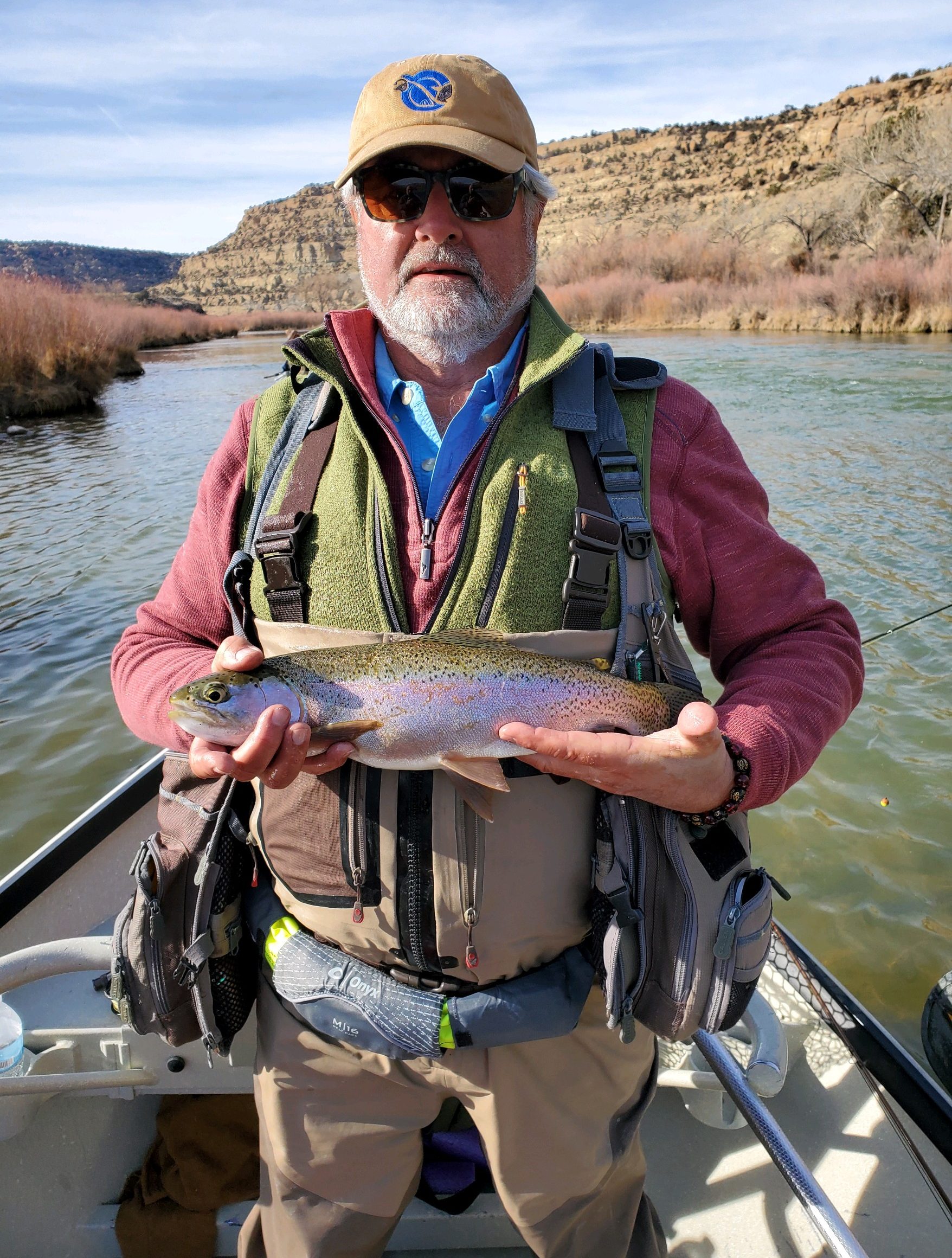Slow start to the day arrived on the stream around eleven am, late for us, high desert elevation around seven thousand feet, air temperature very pleasant around seventy Fahrenheit. Water temperature still cool but warmer than the last time we were there.

This steam works well on hopper dropper combos during the summer when the grasshoppers are out and about. So far this year, we have not seen many hoppers, but still, I decided to give it a go—nice grasshopper with long spindly legs with a size twenty zebra midge underneath. Marc was stripping green-purple leeches.

The water was pretty low and very clear, stealth was the name of the game, long casts way up into deeper moving water was the order of the day. My first cast missed a brown who took my hopper but missed. Marc was further down, about an hour later we meet up, he had two small wild browns on his belt, me nothing, a fat goose egg!!!

We decided to go upstream for the rest of the day. Marc tends to fish faster than I do, so we did not see much of each other. However, when I did catch him up, I was about to pass him when he called me over, said there was a nice brown out in the open feeding on the surface about every three minutes. Sure enough, he was there. I did one perfect cast, by luck rather than skill, landed the hopper three feet above him directly in line with a green and black size eighteen nymph trailing about twenty inches underneath. I watched as my hopper went right over his head, nothing, not a flick, watching as my nymph literally hit him on the head. I was thinking about how to recast over to him when he just slowly swam up into the head of the water under a tree on the other side of the bank. Perfect for Marc to have a go. Several casts later nothing, then Marc hooked a branch and lost his fly. That was that. Just as we were leaving that run, Marc looked down, and there was a nice black woolly bugger stuck in a bush right in front of him. Nice swop out. As the Aussies would say, Fair dinkum mate!!!

After fruitless hours of no hits and not seeing any rises, I was thinking of changing tactics when in a slightly deeper pool, I had a flash nice brown, ok I am going to hunt you down bro! Thirty minutes later, time to change tactics and give this guy a rest.
Sitting away from the run and watching the water, I decided I was going to put on a small beaded copper john about 10 inches under a very small indicator, followed by a size 20 nymph that was red, blue, silver with a slight hackle another twelve inches down on a size six tippet, light and stealthy. Remember, this water is shallow and not moving too fast! Casting up into the faster moving headwater and getting a perfect drift, time, and again nothing. I was starting to think of moving on when he took the nymph, nice fat brown, jumped into the air ran way came back skating on the surface. Shouting to Marc, who was on the next run-up, Got the bugger!!! Reach back for the net, bringing him in across the shallow water dip the net and bam he shook the hook and was gone! At least Marc saw it, not a catch but close no cigar!
Most of you will know this, but I tend to get stuck in a rut when fly fishing on times. You have to mix it up. The point in Hand, stripping flies and dead drifts. Two different techniques, but you can mix the two together.

I was having no luck on dead drifts; Ok, I hear you; he must have had drag on his flies!!! Not the case. I am pretty good with this presentation, as I have done it many times successfully.
Towards the end of the day, I started stripping my indicator along the top water. Not too fast to cause a ripple from the indicator but defiantly fast enough to move the flies underneath through the water column. You can adjust the speed to see what works best, but having the flies under an indicator hanging at different depths then moving them it helps you keep the flies at different levels rather than just stripping without an indicator which will be at one level depending on the size and weight of your flies. I had the other hookups using this method.

We can always learn however. I was fishing with a guide at Lees Ferry AZ last year dead drifting nymphs, my guide came over and said you have some drag on your flies. I looked but did not think so; she re-rigged me with two indicators about eighteen inches apart and told me to recast. I did, and immediately I could see a slight drag on one, it took a while but pretty soon I had them moving in tandem I had eliminated the slight drag I could not see. You live and learn!
The rest of the day was a lot of casting and looking for signs of life. Marc ended up with four landed wild browns. I hooked up another three, but they were soon gone as soon as they took the fly. Never the less a beautiful day in the mountains out chasing wild elusive brown trout in the high desert.
Marc is an expert fly fisherman and knows his stuff, I generally muddle along, but there are days and streams when you need the perfect alignment to catch these spooky fish. I always like to remind myself on days like this, it is a badge of honor when you catch these guys, and it is earnt not given!



